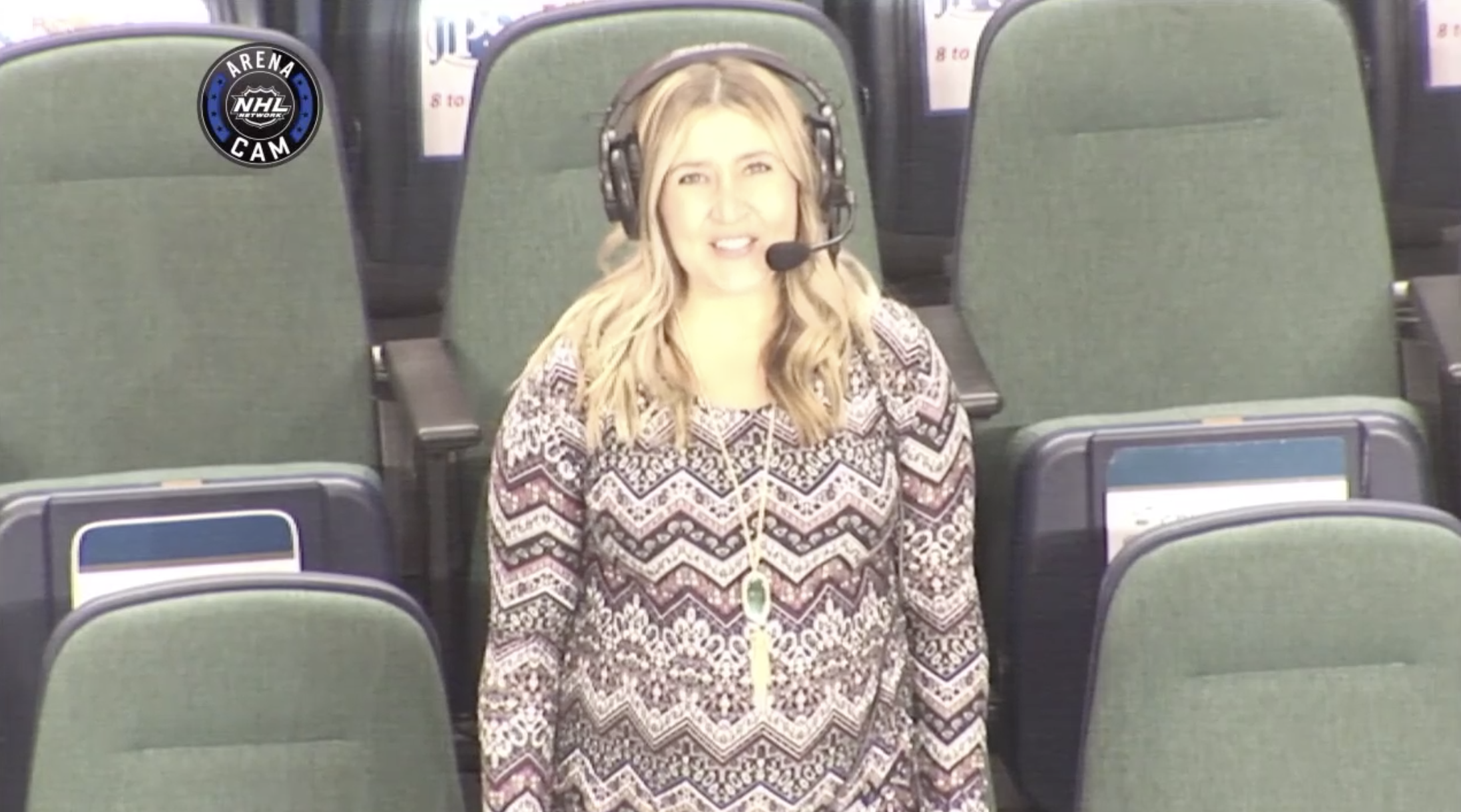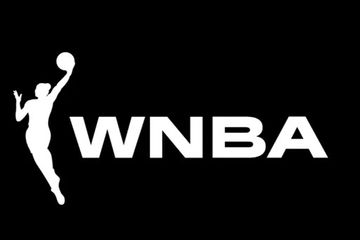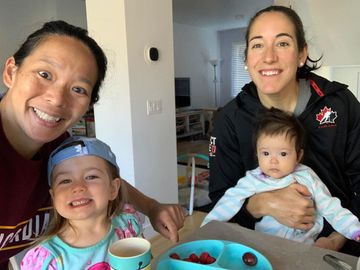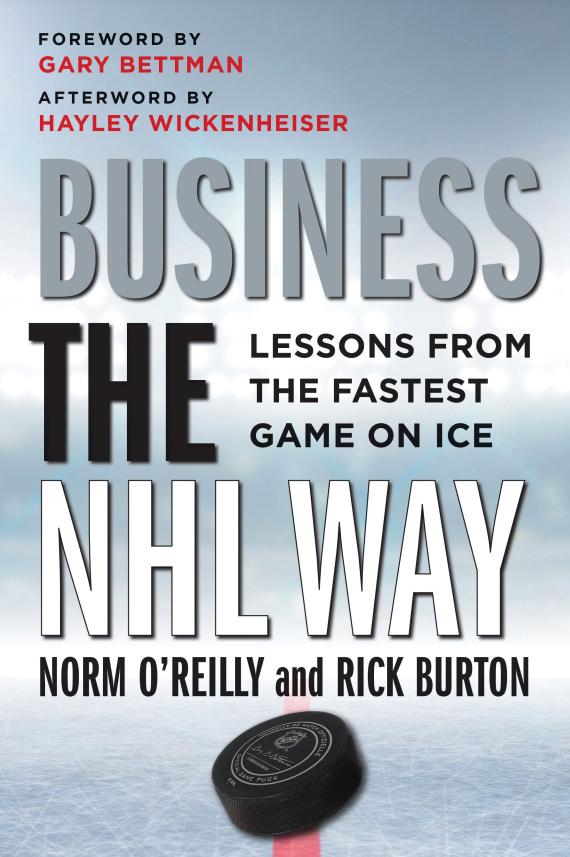Sports journalist Kristen Anderson's journey through motherhood has certainly been an interesting one thus far. Anderson, who wrote about covering the NHL's Calgary Flames while nine months pregnant in a piece for the Calgary Sun in January 2019, is now preparing for her second maternity leave – and the Postmedia writer has learned a lot over the last 21 months.
"The first time, my husband and I were going through it together, not knowing what to expect, not knowing how kids would change your life," Anderson said. "We welcomed our daughter into the world, and I did miss my job. I missed hockey, I missed being around the team and I missed kind of being a source of information."
Quickly, Anderson had gone from bustling hockey games and road trips to cover the Flames to a whole new world. That change didn't come without adjustments and challenges, including a period of postpartum depression.
"It's so common in new mothers," Anderson said. "Especially just with the transition of being a mom, of going from being a career-focused person to being a mom. I think it was really hard on me."
"Then, also all the changes that obviously come with having a new baby: nursing, having this little thing physically dependent on you. There were a lot of things I think that maybe contributed to me wanting to be back at work," she said.
Back to the Rink
Just 10 weeks postpartum, Anderson elected to return to work for Postmedia in April. She was thrust into the middle of the 2019 Stanley Cup Playoffs and a short Flames series against the Colorado Avalanche. While she doesn't necessarily regret her decision to return to work so soon, she does look back on it with question.
"I was concerned before I had my daughter, that I was going to miss all these opportunities that come with long playoff runs, and people were going to kind of forget about me a little bit, and the team was going to sort of forget about me," she said. "And then I look back. I spent the summer with my daughter in Invermere in BC, and I just thought, what was that for?"
"My little baby, of course, she doesn't understand. She's three months old at the time I went back to work," Anderson said. "I've had so many women in my industry that told me about their journeys as well. Cassie Campbell was a big part of that. She went back to work quite quickly as well, and at one point she kind of looked at herself and said, what am I doing, what did I do that for?"
Another factor of her return to work were the physical challenges, like being a working mother who was also breastfeeding.
"The first few months, I have to pump. I was breastfeeding my daughter and in between periods, I would have to go and sit... the Scotiabank Saddledome is so ancient that there's no women's washroom in the press box, or even an area where you could breastfeed," she said. "I got one of the Flames staff to find me an office in their area, and I just went there in between periods and during games."
Her return to sports media was made somewhat easier by a tremendous support system, from the Flames staff who helped with accommodations to family members who assisted with childcare while she was at games or on road trips.
"My husband was such a big influence and help," she said. "When the season started again and I was traveling, it was difficult. It was hard to be away. It was nice to be away, a little bit, just to get a little bit of a break, but it was hard."
"One trip, I was in California," she recalled. "I was on the beach and my husband was dealing with my daughter who was teething and sick and she'd been up all night. It just wrenches your heart to be away from the family when you can't help."
"Mom guilt is a thing, although it's really important for me to have my own career," Anderson added. "I try to coach people away from having mom guilt, because I don't think it's really helpful. But it was really difficult, those moments, and you miss little tiny milestones."
As the NHL resumed play in the past few months amid the ongoing COVID-19 pandemic, Anderson traveled to Edmonton to cover the Flames. She wasn't logistically part of the "bubble" there, so she was able to watch games at Rogers Place but not physically interview the players. But nothing on the ice can compare to one of the moments she'll remember most from her time there.
"My mom was looking after my daughter one day," she said. "My daughter looks at the paper and there's my picture beside my article, and my daughter knew that it was me and where I was and what I was writing. That's so fulfilling, to have your kids see what you do and see what you've worked so hard for. There's never an easy balance, but you try your best and you have to ask for help and support along the way."
While it was challenging being away from her daughter, Anderson found commonalities with her coworkers and even some of the players in knowing what it's like to be away from their families.
"It makes it a little bit easier," she said. "I don't feel like a bad mom being away from her kid. Everybody kind of does it together, has these experiences, and that makes you feel like you're really pursuing your dream and pursuing what you do for a living and you're able to balance it. I think it's so much easier nowadays than it probably was for women sports journalists in my position a number of years ago."
The Second Time Around, and Getting Help
Among the many lessons Anderson learned from her initial journey into parenthood: take the time to spend with your family. While she took only about 10 weeks last time around, Anderson is giving herself a longer timeline now, as she heads into her second maternity leave. Canada's parental leave permits for up to 63 weeks of leave.
"It's such a short time that your baby is that age," she said. "I wouldn't miss it for the world. I should take advantage of that [Canada's parental leave law] because a lot of other places in the world don't have that, especially my colleagues in the U.S."
As it turns out, the situation created by the COVID-19 pandemic and the NHL's shuttering of the 2019-20 season, combined with the uncertainty surrounding the beginning of the 2020-21 season, is a perfect storm for Anderson amidst her second pregnancy. By beginning her maternity leave in mid-October and planning to take a full year, she'll plan to return to work in September 2021 depending on how her family is adjusting and where things are in the sports world.
"I don't even think half of the players knew that I was pregnant, or necessarily noticed that I was gone," she said. "Of course, the personnel, like the coaching staff and management around the team were so good to me and so helpful and they noticed that I was gone. But I think at the end of the day, that extra month might be worth it to spend with my family."
Anderson has spent the last few months mostly working from home, outside of her time adjacent to the Edmonton bubble. The conditions created by the pandemic have expanded her time working from home and been what she calls a blessing.
"My life hasn't changed a heck of a lot," she said, noting that journalists already do a lot of working from home aside from covering practices and games normally. "It's actually been quite an easy transition. Everything is done by Zoom or the teams use this WebEx for conversations you can have. You can have kind of face-to-face chats with players and management, and that's been easy."
"I was able to literally sit on my couch and watch the [NHL] Draft all day, keep in touch with my contacts and figure out what the Flames were doing and then write my stories, literally from home, and put my daughter to bed," she said. "It was honestly the best-case scenario for a working parent in my position."
"Maybe that was one of my biggest fears and kind of produced a lot of my postpartum anxiety," she added. "Just being able to be who I was and still be a mom."
Anderson has the privilege of a family that is willing and able to assist with childcare. She and her husband are also in a place where they are able to hire assistance, something many are simply not able to afford. These reinforcements, combined with the benefits of Canadian family leave laws, make Anderson and her family more fortunate than many others.
Canada's family leave is significantly different from that of the United States, and the length of leave differs by province. New mothers in Alberta, where Anderson is based, can take up to 78 weeks leave with 76 weeks of benefits. Parents are also able to share leave after a child is born, for up to a combined 35 weeks during which standard benefits can be paid.
In the United States, the Family and Medical Leave Act "requires employers to provide up to 12 weeks of unpaid leave for several medical conditions, as well as the birth of a baby." Employers with fewer than 50 employees are exempt, and it is estimated that only about 60 percent of workers are actually eligible. According to The Guardian, the United States is the only country examined by the Organisation for Economic Co-operation and Development without a national statutory paid maternity, paternity, or parental leave.
Childcare costs, meanwhile, are a significant burden for many in both the United States and Canada. According to a May 2019 Survey of Income and Program Participation (SIPP), average childcare costs amount to nearly 10 percent of the average family income in the United States, among working families with children under 5 who pay for care. That is 40 percent higher than the U.S. Department of Health and Human Services' definition of affordability, which considers childcare affordable "if it costs families no more than 7 percent of their income."
Of course, this issue also disproportionately affects lower-income families, who spend a much higher percentage of their income on childcare – if they can afford it at all. According to the 2016 National Survey of Early Care and Education, "the majority of poor and low-income children from birth to age 3 are cared for by a parent or by an unpaid caregiver, such as a grandparent or other relative." Typically, after age three, child can be enrolled in a preschool or pre-kindergarten.
Families in the U.S. who are unable to afford quality childcare are encouraged to apply for financial assistance, including subsidies and resources from employers and schools. There are also tax credits for those who pay for child care so they can work or look for work. Visit ChildCare.gov for more details about these programs.
In Canada, childcare costs vary greatly depending on region. A 2019 report showed the monthly median cost for infant care in Toronto was $1,774 CAD. Meanwhile, in Quebec, there is a provincially set fee of $8.35/day. In Manitoba, the median fee is $651 per month. In Lethbridge, the cheapest city in Alberta that was in the study, infant care was $900 per month and $850 per month for toddlers.
Although new federal policies announced in 2017 have helped shape childcare and lower costs to some extent, childcare costs in Canada remain exorbitant. Simply put, many simply do not earn enough to be able to afford it. According to the aforementioned 2016 study for the Organisation for Economic Co-operation and Development, the average two-income family in Canada spends about 22.2 percent of their net salary on childcare. Single parents spend nearly a third of their income.
Similar to the United States, families in Canada may seek out government subsidies and grants to help pay for child care. Examples include the Canada Child Benefit, a tax-free monthly payment, and the Ontario Child Benefit. You can learn more about the Canada Child Benefit, its rules for eligibility and more here.
Now is also a good time to point out this unnecessarily sexist standard that works to reinforce the trope that women are more natural caregivers, a role which disproportionately burdens them:
"When both a female and male parent live in the same home as the child, the female parent is usually considered to be primarily responsible for the care and upbringing of the child. She should be the one applying for the CCB."
With all that said, both parental leave and childcare circumstances leave much to be desired, particularly in the United States – but also in Canada to some extent.
Anderson's ability to balance career, pregnancy, and family is an example of how people can flourish and enjoy their lives when they receive necessary benefits from their employers and their government.
Postpartum Depression & Finding a Balance
For many, postpartum depression is considered a taboo topic; that isn't the case for Anderson.
"I think it's important to be open about it," she said. "It's never too late to ask for help. It doesn't matter if it's one week, or two weeks, or a year. It took me a year to recognize where I was mentally and to get help and ask for help. That's the biggest thing: it's never too late to recognize where you're at mentally, and it's totally okay to ask for help."
According to the Centre for Addiction and Mental Health (CAMH), postpartum depression "usually starts within the first month after childbirth (although it can occur any time within the first year) and can last weeks to months. PPD is clinically no different from a depressive episode that occurs at any other time in a woman's life. However, not surprisingly, the symptoms of PPD often focus on motherhood or infant care."
(Although the CAMH definition refers specifically to women, postpartum depressive episodes can occur for a parent of any gender, including the partner of the person who gives birth.)
More from CAMH:
"PPD if prolonged and untreated is detrimental to the mother’s health and can disrupt family relations, undermine infant-mother attachment and impair the child’s long-term development. Society’s messages that new motherhood should be a happy time can create barriers to getting help. A new mother may be reluctant to recognize that she needs help with depression or may not seek treatment because she fears admitting (even to herself) how she is feeling (or not feeling) about her baby."
According to CAMH, postpartum depression affects an average of 13 percent of people who give birth (O'Hara & Swain, 1996). The good news is, as Anderson said, there's help out there – and parents shouldn't be afraid to seek it.
"It's okay to consult modern medicine," she said. "There are all types of drugs that are available for women and that are totally safe for breastfeeding, that will help take the edge off and take those thoughts away that come with postpartum, that comes with that anxiety."
"This isn't like our parents' generation or even our grandparents' generation. We don't need to do it all on our own," Anderson added. "If you talk to any women from those generations, they probably would've liked help, the type of help we have now. It exists for a reason. Don't be too proud to ask for help because we all do it."
"We don't need to be superheroes," she said. "We're not meant to do everything and be at our daughter's beck and call at the time, be a superhero wife, a superhero daughter, an incredibly gifted writer and a news-breaking reporter. We're just not. That's my biggest piece of advice: ask for help."
Although she certainly has more on her plate now than she did before parenthood, Anderson said the key principles behind balancing her career with being a mother ring true with other aspects of life as well.
"It's something we do on a daily basis," she said. "Regardless of if you have kids or not, we live in an age where we're constantly balancing our time with work and spending time with our family and friends. It's the best job in the world. If you have the opportunity to have kids, it's so rewarding. You figure it out, you ask for help and you get the help you need. You just make it work."
Before she knows it, Anderson and her family will be making it work with another little one in the home. When that time comes, she'll focus on enjoying her newly-expanded family – and maybe she'll miss the rink and the team, but they'll still be there to welcome her back when she's ready.







